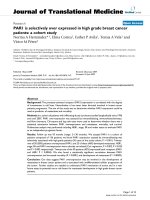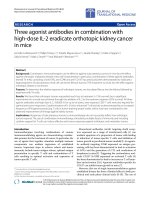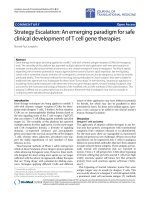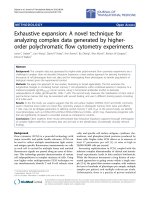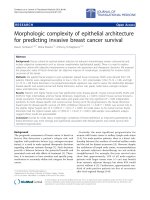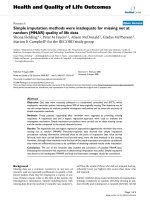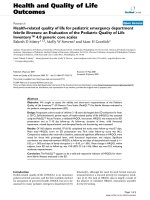Báo cáo hóa học: " Copper nanofiber-networked cobalt oxide composites for high performance Li-ion batteries" potx
Bạn đang xem bản rút gọn của tài liệu. Xem và tải ngay bản đầy đủ của tài liệu tại đây (2.28 MB, 7 trang )
NANO EXPRESS Open Access
Copper nanofiber-networked cobalt oxide
composites for high performance Li-ion batteries
Sang Hoon Nam
1
, Yong Seok Kim
1
, Hee-Sang Shim
2
, Jong Guk Kim
1
and Won Bae Kim
1,2*
Abstract
We prepared a composite electrode structure consisting of copper nanofiber-networked cobal t oxide
(CuNFs@CoO
x
). The copper nanofibers (CuNFs) were fabricated on a substrate with formation of a network
structure, which may have potential for improving electron percolation and retarding film deformation during the
discharging/charging process over the electroactive cobalt oxide. Compared to bare CoO
x
thin-film (CoO
x
TF)
electrodes, the CuNFs@CoO
x
electrodes exhibited a significant enhancement of rate performance by at least six-fold
at an input current density of 3C-rate. Such enhanced Li-ion storage performance may be associated with modified
electrode structure at the nanoscale, improved charge transfer, and facile stress relaxation from the embedded
CuNF network. Consequently, the CuNFs@CoO
x
composite structure demonstrated here can be used as a promising
high-performance electrode for Li-ion batteries.
Introduction
Cobalt oxide (CoO
x
) is a high-capacity electrode mate-
rial for Li-ion batteries with a theoretical capacity of at
least two times greater than that of graphite (ca.370
mAh g
-1
) [1]. However, the cobalt oxides show large
irreversible capacity and poor cycling performance
caused by Li-alloy ing, agglomeration or growth of passi-
vation layers [1]. In addition, severe volume expansion
during discharge/charge process accelerates fading of
the capacity, and electrical contact between the elec-
trode material and current collector eventually fails. To
overcome these problems, several strategi es that employ
a secondary material [2], a chemically or physically pre-
pared surface coating [3], size optimization [4,5], and
fabrication of a nanostructure [6] have been reported.
These approaches generally provide a facile electroche-
mical reaction route, high conductivity, and structural
stability. In particular, nanostuctured electrode materials
are expected to be well-suited for next-generation Li-ion
batteries due to their substantially increased reaction
area and facilitated charge carrier transport through
shortened Li-ion diffusion paths [ 7]. For example, Kim
et al. [8] proposed a core- shell nanorod array elect rode,
which consists of a metallic conducting core with a
vanadium oxide (VO
x
) shell layer. Such highly conduct-
ing core-embedded nanostructure was capable of enhan-
cing the electrochemical properties of the VO
x
electrodes
even though the electroactive materials have high elec-
trical resistance. In addition , incorporation of metal into
active material was found to increase the charge transfer
in electrode materials along with facilitated Li-ion diffu-
sion [9]. Therefore, it is expected that the incorporati on
of highly conducting metal nanowires into cobalt oxide
materials would be a promising way to increase electri-
cal conductivity and mitigate the particle agglomeration
of the cobalt oxide during Li-ion insertion/extraction.
In this report, we prepared cobalt oxide electrode that
is composited with copper nanofiber network, and
demonstrated that such embedded nanostructure is able
to enhance electrical conductivity and mechanical stabi-
lity for the CoO
x
electrode during repeated cyclings.
Experimental
Fabrication of Cu nanofiber-embedded cobalt oxide
composites
The composite nanostructure of copper nanofiber-net-
worked cobalt oxide (CuNFs@CoO
x
) was prepared by
using an electrospinning process to produce the copper
nanofibers and followed by a radio frequency magnetron
sputtering (RF sputtering) to deposit the CoO
x
materials.
The electrospinning solution was prepared by mixing
* Correspondence:
1
School of Materials Science and Engineering, Gwangju Institute of Science
and Technology (GIST), 261 Chemdan-gwagiro, Buk-gu, Gwangju 500-712,
South Korea
Full list of author information is available at the end of the article
Nam et al. Nanoscale Research Letters 2011, 6:292
/>© 2011 Nam et al; licensee Sp ringer. This is an Open Access article d istrib uted under the terms of the Creative Commons Attribution
License (http://creativecommons .org/license s/by/2.0), which permits unrestricted use, distribution, and reproduction in any medium,
provided the original work is properly cited.
copper(II) chloride dihydrate (CuCl
2
2H
2
O, Sigma-
Aldrich, Saint Louis, USA), methanol, and polyvinylpyr-
rolidone (PVP; M
w
= 1,300,000 g mol
-1
, Sigma-Aldrich,
Saint Louis, USA). The solution was then immediately
loaded into a syringe, which was attached to a 23-gauge
stainless steel needl e. A 10-kV electric field was applied
between the needle tip and a grounded stainless steel
disc at a distance of 10 cm. The stainless steel substrate
was mechanically polished before use with a sandpaper
and diamond paste (ca. 0.3 μm) until a mirror-like sur-
face was obtained. Subsequently, the collected CuCl
2
/
PVP composite on the substrate was heated at 300°C for
3 h in air. To obtain the metallic CuNFs, a reduction
treatment was perfo rmed at 200°C in H
2
atmosphere at
aflowrateof60sccm.Next,CoO
x
was deposited onto
the Cu nanofibers-formed substrate via RF sputtering
with an cobalt oxide target under an inert Ar gas atmo-
sphere at a working pressure of 1 × 10
-3
Torr. The
deposition thickness of the CoO
x
was controlled to ca.
100 nm. The mass ratio of the deposited CuNFs and
CoO
x
was measured to be 2:3 using a micro-balance
(Sartorius, M3P). The mass of the electrodes was con-
trolled to have the similar quantity (ca. 0.125 mg) of
CoO
x
as the active material.
Characterization
The microstructures were characterized by field emission
scanning electron microscopy (FESEM, Hitachi S-4700)
and x-ray diffraction (XRD, Rigaku Ru-200B). To mea-
sure the thickness and investigate the cross section, the
electrodes were deposited onto Si substrates instead of
stainless steel substrates. The composition of the depos-
ited CoO
x
was character ized by x-ray photoelectron spec-
troscopy (XPS, VG Multilab 2000) with a monochromic
Al K
a
x-raysource(E = 1486.6 eV). Data proces sing was
performed using the Avantage 4.54 software program.
The background was corrected using the Shirley method,
and the binding energy of the C 1s peak from the support
at 284.5 eV was taken as an internal standard.
Electrochemical measurements
The electrochemical tests were performed using a two-
electrode system fabricated with the prepared materials
for the working electrode and metallic Li for the counter
electrode in an Ar-circulating glove box. A 1-M LiPF
6
solution in a 1:1 volume mixture of ethylene carbonate
and diethyl carbonate was used as the electrolyte. The gal-
vanostatic discharge/charge mode at various C-rates from
0.15 to 3C was conducted with a potential window of 2.5
to 0.01 V (vs. L i/Li
+
) using a battery cycler (WonA tech,
WBCS3000). 0.15C rate corresp onds to a current rate of
0.135 A g
-1
of Co
3
O
4
, in which the theoretically complete
discharge could be achieved in 6.7 h, and 3C rate corre-
sponds to 2.7 A g
-1
. The AC impedance measurement was
performed using a Solartron 1260 frequency response ana-
lyzer. An amplitude voltage of 5 mV was applied over the
frequency range from 100 kHz to 10 mHz.
Results and discussion
Morphology and microstructure
Figure 1a shows that the prepared CuNFs were depos-
itedontheSisubstrateandtheyhaveanaveragedia-
meter of ca. 50 ± 2 0 nm. The surface morphology of
the individual CuNF can be observed in the inset figure
ofFigure1a.Figure1bshowsthebareCoO
x
film struc-
ture. On the other hand, Figure 1c represents a com-
bined morphology o f both nanostructures of the
one-dimensional CuNFs and the CoO
x
.TheCuNFs@-
CoO
x
has a rough surface compared to the bare
CoO
x
TF, which may be ascribed to the presence of the
CuNF network on the substrate. The sputtered CoO
x-
was deposited not only on the substrate but also on the
surface of CuNFs. After CoO
x
deposition, all the CuNFs
seem to be covered by the CoO
x
layer.
The crystalline information and chemical composition
of deposited electrode materials have been elucidated by
XRD and XPS. Figure 2a compares the XRD patterns of
CuNFs, CoO
x
TF, and CuNFs@CoO
x
, respectively. The
sputtered CoO
x
on the stainless steel substrate indicated
an amorphous nature because the diffraction pattern did
not show any crystalline peaks from cobalt oxides, except
the well-defined peaks from the stainless steel disc. The
amorphous phase typically exhibits a high capacity and
good cycling performance due to the internal stress
relaxation generated by discharge/charge process [10].
The characteristic peaks of the CuNFs were observed at
the expected d iffraction angles from the Cu(111) and Cu
(200) planes [JCPDS 04-0836]. In order to confirm the
chemical state of deposited CoO
x
, XPS analysis was
employed. In Figure 2b, the deposited CoO
x
gives two
main peaks at 779.8 and 795.1 eV due to the Co 2p
3/2
and Co 2p
1/2
, respectively, together with two satellite
peaks at 788.6 and 803.7 eV. The peak splitting between
Co 2p
3/2
and Co 2p
1/2
, corresponding to the spin-orbit
doublet of the Co 2p, is ca. 15.3 eV, and the weak and
broad satellite peak of the Co 2p
3/2
appears at ca. 9 eV
higher than the main p eak. Such a low-intense satellite
canbeconsideredasanindicationoftheCo
3
O
4
phase
[11,12], while the satellite peak of the CoO phase is rela-
tively more intense (ca. 3 0% of the total Co 2p
3/2
signal)
[13]. These results indicate that t he sputtered CoO
x
is
dominantly of Co
3
O
4
phase, which is c onsistent with its
electrochemical properties, as will be discussed later.
Electrochemical properties
ToinvestigatetheinfluenceofCuNFsontheLiions
storage performance of the CoO
x
, we conducted galva-
nostatic discharge/charge processes. Figure 3a shows the
Nam et al. Nanoscale Research Letters 2011, 6:292
/>Page 2 of 7
first and second discharge/charge voltage profiles at a
constant 0.15C between the voltages of 2.5 and 0.01 V
(vs. Li
+
/Li). Both CoO
x
TF and CuNFs@CoO
x
exhibit the
plateau around 1.0 V in the first discharge curve. This is
associated with the following electrochemical reaction
[14] of Co
3
O
4
+8Li
+
+8e
-
® 4Li
2
O+3Co.The
CuNFs@CoO
x
seems to have a little bit larger irreversi-
ble capacity of ca. 240 mAh g
-1
compared to the bare
CoO
x
TF, which could be caused by the enlarged contact
area between the electrolyte and electrode material [7].
Although the CuNFs@CoO
x
electrode indicated a con-
version profile similar to that of the CoO
x
TF, the capa-
city was ca. 30% higher than that of the bare CoO
x
TF,
asshowninFigure3b.Thehighlyruggedmicrostruc-
ture of CuNFs@CoO
x
might be responsible for the
increased reaction sites along the CuNF network, mak-
ing the electrochemical reaction more efficient with Li
ions, because the electrochemical performance can be
dependent on the textual characteristics of the electro-
des [15]. In addition, it was also reported that the incor-
poration of nanostructure into a Li host matrix
Figure 1 FESEM images. (a) Horizontally layered CuNFs (the inset
shows a highly magnified image of the prepared nanofiber);
(b) CoO
x
TF prepared by RF-sputtering (the inset shows the
deposited thin-film thickness); (c) the composite structure of
CuNFs@CoO
x
(the inset shows the cross-sectional view of the
nanofiber and thin-film, respectively).
Figure 2 Microstructura l properties. (a) x-ray diffraction patterns
of the CuNFs, CoO
x
TF, and CuNFs@CoO
x
on a stainless steel disc. For
the case of CuNFs, we loaded a large amount of CuNFs to acquire a
significant signal. The asterisk mark can be indexed to the stainless
steel substrate; (b) x-ray photoelectron spectrum for Co 2p
3/2
and
2p
1/2
of the sputtered CoO
x
.
Nam et al. Nanoscale Research Letters 2011, 6:292
/>Page 3 of 7
exhibited an enhanced reversible capacity [8,16]. The
coulombic efficiency (the ratio of the number of charges
that enter the electrode to the number that can be
extracted from the electrode) was more than 90% except
for the initial few cycles, which suggests that the
inserted Li ions were reversibly extracted. Figure 3c
shows the current density dependence on the discharge
capacities of the CoO
x
TF and CuNFs@CoO
x
at 0.15, 0.3,
0.6, 1.2, 2.5, and 3C-rates. The capacity of the CoO
x
TF
decreased rapidly with increasing current density, which
is consistent with previously reported results [15,17],
whereas the CuNFs@CoO
x
was able to maintain 50% of
its initial capacity even at 3C-rate. Such enhanced
performance of t he CuNFs@CoO
x
can be attributed to
the improvement of the electrical conductivity of the
CoO
x
by the embedded CuNF network, which creates an
efficient electron percolat ion path between the current
collector and the active material [8].
To elucidate reason of the enhanced performan ce, the
differential capacity was examined. Figure 4a, b was
obtained from t he first and tenth cycles, respectively. At
the firs t cycle (Figur e 4a), the intensity of the CuNFs@-
CoO
x
was larger than that of the CoO
x
TF, showing
higher capacity and faster kinetics of the phase transfor-
mation. In Figure 4b, the decrea sed peak intensity and
integral areas could be caused from the irreversible
capacity due to the incomplete electrochemical reaction.
Herein, it is interesting to find that some amount of
previously formed Li
2
O phase would contribute to the
capacity at t enth cycle. The formed Li
2
O has been gen-
erally reported to be elec trochemically inactive. How-
ever, it was also reported that Li
2
Obelow10nmcould
be activated [1]. The activated Li
2
O can take place in
the cyclic voltammetry results [18-20]. Two cathodic
peaks at 0.82 and 1.15 V were observed in the first cycle
in Figure 4a, but they were shifted to 0.95 and 1.18 V,
Figure 3 Galvanostatic mode at 0.15C. The potential curves of (a)
the initial cycling profiles; (b) the specific capacity with cycling
number; (c) the rate performance test for various C-rates of 0.15 to 3C.
Figure 4 Calculated differential capacity plots. (a) the first cyc le;
(b) the tenth cycle of the CoO
x
TF and CuNFs@CoO
x
. The discharge
process represents oxidation, while the charge process represents
reduction processes.
Nam et al. Nanoscale Research Letters 2011, 6:292
/>Page 4 of 7
respectively, in the subsequent cycles as shown in Figure
4b, indicating that the electrochemical reactions might
be different from the first cycle. Thus, the electrochemi-
cal reactions in the CuNFs@CoO
x
composite with Li
ions can involve the following steps [21-23]:
Co
3
O
4
+ 8Li
+
+8e
−
→ 4Li
2
O+ 3Co
first discharge
Co + Li
2
O ↔ CoO + 2Li
subsequent charge/discharge
The first discharge process is an irreversible reaction
of Co
3
O
4
and Li, which for ms metallic Co and Li
2
O
phase. During the first charge process, the Co and
Li
2
O forms CoO instead of Co
3
O
4
owing to the simi-
larity of oxygen lattice in the Li
2
OandCoO[24].In
the subsequent discharge/charge processes, the modi-
fied oxygen lattice is continuously preserved, indicating
that the reaction of CoO with Li develops into reversi-
ble cycles.
In Figure 5, AC impedance measurements were per-
formed to probe the kinetic factors contributing to the
capacity and rate performance. The equivalent circuit
analysis is based on a Randles equivalent circuit for an
electrochemical system, in which R
b
is the bulk resis-
tance, corresponding to the resistance value at the
high-frequency intercept of the semicircle with the real
axis [9,25]. R
ct
and C
ct
are the resistance of the
charge-transfer and double-layer capacitance, respec-
tively. The R
b
value of the CuNFs@CoO
x
was similar to
that of the bare CoO
x
TF electrodes, whereas the R
ct
and C
ct
values for the CuNFs@CoO
x
were much smal-
ler than those for CoO
x
TF. A considerable change in
the sum of R
SEI
and R
ct
from 344 Ω was observed for
CoO
x
TF to 96 Ω for CuNFs@CoO
x
, indicating an
enhanced electrical conductivity arising from the
composite, which implies that the charge transfer was
significantly improved by the embedded CuNF network
structure within the CoO
x
TF. This result confirmed
that the embedded CuNF network could not only
contribute to the high conductivity of the overall elec-
trode, but also largely improve the electrochemical
properties of CoO
x
during the cyclings.
Mechanical stability
Figure 6 shows the FESEM images of the CoO
x
TF and
CuNFs@CoO
x
after the 30th cycle. Two samples were
disassembled after the electrochemical cycles in order to
characterize the changes in the morphology. The
CoO
x
TF appeared to experience serious cracking and
crumbling, as shown in Figure 6a, while the CuNFs@-
CoO
x
seemed to remain fairly stable, as shown in Figure
6b. The CuNFs@CoO
x
maintained the integrity of the
Figure 5 AC impedance spectra for both samples.The
experimental results are presented as Nyquist plots by applying a
sine wave with amplitude of 5 mV over the frequency range 100
kHz to 10 mHz, which were measured at E = 1.6 V (vs. Li
+
/Li) after
the cycles.
Figure 6 FESEM images of the cycled CoO
x
electrodes. (a)
without and (b) with the Cu NFs after 30th cycle. The tested
electrodes were disassembled and extracted from the Li-ion cell.
Nam et al. Nanoscale Research Letters 2011, 6:292
/>Page 5 of 7
electrode with the current collector, suggesting the com-
posite has the greater stress relaxation than the bare
CoO
x
TF despite its higher capacity. This result implies
that the embedded CuNF network significantly compen-
sates the generated stress compared with the CoO
x
TF
without the nanostructure. Thus, our results support the
conclusion that embedded CuNF network nanostruc-
tures can significantly improve the capacity, rate perfor-
mance, and mechanical stability of the CoO
x
electrode
materials.
Conclusions
ACuNFs@CoO
x
composite electrode was fabricated to
serve as an anode for rechargeable Li-ion batteries.
As an efficient Li-ion battery anode material, CuNFs@-
CoO
x
exhibited a higher capacity and rate performanc e
than bare CoO
x
TF without CuNFs; the capacity at
0.15C was increased by ca. 30%, and the capacity was
maintained above 50% even at 3C. These enhancements
could be attributed to an increased number of reaction
sites, facilitated charge transport, a decreased electroche-
mical double-layer capacitance, and facile stress relaxa-
tion by embedded CuNF network within the CoO
x
.
Consequently, this CuNFs@CoO
x
composite structure
can be a promising candidate for use in the electrodes
of high-performance Li-ion batteries.
Abbreviations
CuNFs@CoO
x
: copper nanofiber-networked cobalt oxide; CuNFs: copper
nanofibers; CoO
x
TF: cobalt oxide thin-film; CoO
x
: cobalt oxide; FESEM: field
emission scanning electron microscopy; PVP: polyvinylpyrrolidone; VO
x
:
vanadium oxide; XPS: x-ray photoelectron spectroscopy; XRD: x-ray
diffraction.
Acknowledgements
This work was supported by Basic Science Research Program through the
National Research Foundation of Korea (NRF) funded by the Ministry of
Education, Science and Technology (R15-2008-006-03002-0) and by the
Korean government (MEST) (no. 2010000018) and by the Core Technology
Development Program for Next-generation Solar Cells of Research Institute
of Solar and Sustainable Energies (RISE), GIST.
Author details
1
School of Materials Science and Engineering, Gwangju Institute of Science
and Technology (GIST), 261 Chemdan-gwagiro, Buk-gu, Gwangju 500-712,
South Korea
2
Research Institute for Solar and Sustainable Energies (RISE),
Gwangju Institute of Science and Technology (GIST), 261 Chemdan-gwagiro,
Buk-gu, Gwangju 500-712, South Korea
Authors’ contributions
SHN and WBK designed and drafted the study. SHN and YSK fabricated the
electrode using the electrospinning and sputtering. HSS and JGK
participated in the characterization. All authors read and approved the fina l
manuscript.
Competing interests
The authors declare that they have no competing interests.
Received: 27 November 2010 Accepted: 5 April 2011
Published: 5 April 2011
References
1. Poizot P, Laruelle S, Grugeon S, Dupont L, Tarascon J-M: Nano-sized
transition-metal oxides as negative-electrode materials for lithium-ion
batteries. Nature 2000, 407:496.
2. Kim D-W, Ko Y-D, Park J-G, Kim B-K: Formation of lithium-driven active/
inactive nanocomposite electrode based on Ca
3
Co
4
O
9
nanoplates.
Angew Chem Int Ed 2007, 46:6654.
3. Liu H, Bo S, Cui W, Li F, Wang C, Xia Y: Nano-sized cobalt oxide/
mesoporous carbon sphere composites as negative electrode material
for lithium-ion batteries. Electrochim Acta 2008, 53:6497.
4. Ahn H-J, Choi H-C, Park K-W, Kim S-B, Sung Y-E: Investigation of the
structural and electrochemical properties of size-controlled SnO
2
nanoparticles. J Phys Chem B 2004, 108:9815.
5. Kang J-G, Ko Y-D, Park J-G, Kim D-W: Origin of capacity fading in nano-
sized Co
3
O
4
electrode: Electrochemical impedance spectroscopy study.
Nanoscale Res Lett 2008, 3:390.
6. Lou XW, Deng D, Lee JY, Feng J, Archer LA: Self-supported formation of
needlelike Co
3
O
4
nanotubes and their application as lithium-ion battery
electrodes. Adv Mater 2008, 20:258.
7. Guo Y-G, Hu J-S, Wan L-J: Nanostructured materials for electrochemical
energy conversion and storage devices. Adv Mater 2008, 20:2878.
8. Kim Y-S, Ahn H-J, Nam SH, Lee SH, Shim H-S, Kim WB: Honeycomb pattern
array of vertically standing core-shell nanorods: Its application to Li
energy electrodes. Appl Phys Lett 2008, 93:103104.
9. Nam SH, Shim H-S, Kim Y-S, Dar MA, Kim JG, Kim WB: Ag or Au
nanoparticle-embedded one-dimensional composite TiO
2
nanofibers
prepared via electrospinning for use in lithium-ion batteries. ACS Appl
Mater Interfaces 2010, 2:2046.
10. Idota Y, Kubota T, Matsufuji A, Maekawa Y, Miyasaka T: Tin-based amorphous
oxide: A high-capacity lithium-ion-storage material. Science 1997, 276:1395.
11. Castner DG, Watso PR, Chan IY: X-ray absorption spectroscopy, x-ray
photoelectron spectroscopy, and analytical electron microscopy studies
of cobalt catalysts. 1. Characterization of calcined catalysts. J Phys Chem
1989, 93:3188.
12. Emst B, Libs S, Chaumette P, Alain K: Preparation and characterization of
Fischer-Tropsch active Co/SiO
2
catalysts. Appl Catal A 1999, 186:145.
13. Dedryvère R, Laruelle S, Grugeon S, Poizot P, Gonbeau D, Tarascon J-M:
Contribution of x-ray photoelectron spectroscopy to the study of the
electrochemical reactivity of CoO toward lithium. Chem Mater 2004,
16:1056.
14. Larcher D, Sudant G, Leriche J-B, Chabre Y, Tarascon J-M: The
electrochemical reduction of Co
3
O
4
in a lithium cell. J Electrochem Soc
2002, 149:A234.
15. Barreca D, Cruz-Yusta M, Gasparotto A, Maccato C, Morales J, Pozza A,
Sada C, Sánchez L, Tondello E: Cobalt oxide nanomaterials by vapor-
phase synthesis for fast and reversible lithium storage. J Phys Chem C
2010, 114:10054.
16. Taberna PL, Mitra S, Poizot P, Simon P, Tarascon J-M: High rate capabilities
Fe
3
O
4
-based Cu nano-architectured electrodes for lithium-ion battery
applications. Nat Mater 2006, 5:567.
17. Yu Y, Chen C-H, Shui J-L, Xie S: Nickel-foam-supported reticular CoO-Li
2
O
composite anode materials for lithium ion batteries. Angew Chem Int Ed
2005, 44:7085.
18. Wang GX, Chen Y, Konstantinov K, Lindsay M, Liu HK, Dou SX: Investigation
of cobalt oxides as anode materials for Li-ion batteries. J Power Sources
2002, 109:142.
19. Do J-S, Weng C-H: Electrochemical and charge/discharge properties of
the synthesized cobalt oxide as anode material in Li-ion batteries.
J Power Sources 2006, 159:323.
20. Li W-Y, Xu L-N, Chen J: Co
3
O
4
nanomaterials in lithium-ion batteries and
gas sensors. Adv Funct Mater 2005, 15:851.
21. Chou S-L, Wang J-Z, Liu H-K, Dou S-X: Electrochemical deposition of
porous Co
3
O
4
nanostructured thin film for lithium-ion battery. J Power
Sources 2008, 182:359.
22. Fu Z-W, Wang Y, Zhang Y, Qin Q-Z: Electrochemical reaction of
nanocrystalline Co
3
O
4
thin film with lithium. Solid State Ion 2004, 170:105.
23. Li C, Yin X, Chen L, Li Q, Wang T: Synthesis of cobalt ion-based
coordination polymer nanowires and their conversion into porous
Co
3
O
4
nanowires with good lithium storage properties. Chem Eur J 2010,
16:5215.
Nam et al. Nanoscale Research Letters 2011, 6:292
/>Page 6 of 7
24. Obrovac MN, Dunlap RA, Sanderson RJ, Dahn JR: The electrochemical
displacement reaction of lithium with metal oxides. J Electrochem Soc
2001, 148:A576.
25. Yang SB, Song HH, Chen XH: Electrochemical performance of expanded
mesocarbon microbeads as anode material for lithium-ion batteries.
Electrochem Commun 2006, 8:137.
doi:10.1186/1556-276X-6-292
Cite this article as: Nam et al.: Copper nanofiber-networked cobalt
oxide composites for high performance Li-ion batteries. Nanoscale
Research Letters 2011 6:292.
Submit your manuscript to a
journal and benefi t from:
7 Convenient online submission
7 Rigorous peer review
7 Immediate publication on acceptance
7 Open access: articles freely available online
7 High visibility within the fi eld
7 Retaining the copyright to your article
Submit your next manuscript at 7 springeropen.com
Nam et al. Nanoscale Research Letters 2011, 6:292
/>Page 7 of 7
